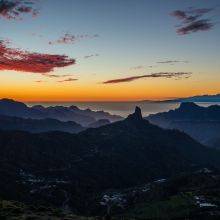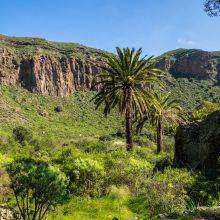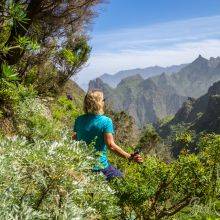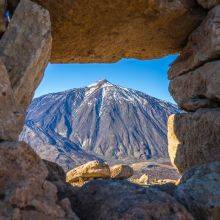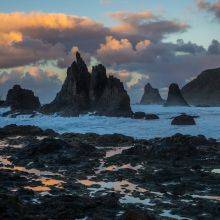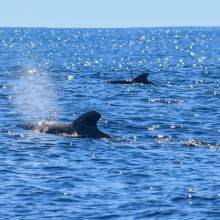When Is the Best Time
Gran Canaria is popular for its fantastic weather and beaches throughout the year. Even in the winter, the day temperatures are above 20°C. More than 4 million visitors enjoy the mild climate in Gran Canaria annually and the white sandy beaches in the south.
You are able to walk barefoot along the beaches and go for a swim for the entire year. I prefer the wintertime in Gran Canaria to escape the cold temperatures. My guide became so much bigger than expected, but Gran Canaria is exceptional. Therefore, below, I added the Table of Contents for the 10 Must-Visit Beaches and more guides "The 5 Best Sunset Spots", Caldera de Bandama, Vacas Canyon, and don't miss out on my printable Gran Canaria Map with all highlights below.
The best times to visit Gran Canaria for excellent weather, pleasant sea temperatures and fewer crowds are September and October, followed by May and June—more about the weather and seasons below.
Check out my Table of Contents and jump immediately to the beach you are looking for.
Gran Canaria Map

5 Top Beaches in Gran Canaria
The beaches are listed clockwise. There are more lovely beaches spread around the island, and all mentioned beaches are perfect for swimming and or snorkelling.
1 Playa de Tufia - East
This is a gem of a beach and my second favourite because the protected bay is ideal for snorkelling. You can either relax on the tiny beach or along the rocky coastal shore during low tide.
There is plenty of parking available on top of the cliffs, and it's a two-minute walk to the fisherman village and the sea. This picturesque village with its white houses is utterly beautiful, and there is just a small bar, nothing else. Bring water and a snack and if you like to snorkel, this underwater treasure is your place.
It is also excellent for diving; easy to get in. Tufia itself is a protected area due to its history of still-inhabited cave dwellings. Playa de Tufia (Google Maps)
2 Playa de Maspalomas - South
The “Dunas de Maspalomas” in Gran Canaria are for sure unique and the most visited sight. When we visited the dunes for the first time, we were utterly amazed, and we didn’t expect such a desert vibe here.
3 Playa Nudista Montaña Arena
By chance, we stopped at Playa las Carpinteras, the beach of the carpenters, for a break. We saw many people walking on a coastal path to the south and followed them. It is a 10 minutes walk on a rough trail; proper shoes are necessary. The secluded Montana Arena beach is well protected from the wind.
Although a nudist beach, there are more people with textiles nowadays. You have to bring everything you need; water, food, a parasol. Even a public bus stops at the main road nearby. Playa Nudista Montana Arena (Google Maps)
4 Playa de Amadores - Southwest
Amadores beach is probably the most beautiful of all beaches in Gran Canaria. This human-made beach with its shallow turquoise waters is an eye-turner. Sunbeds and parasols are for rent, essential even in the winter. Water sports activities, restaurants, bars, a small supermarket, and public restrooms are available.
Also, this beach and bay are well protected, and the calm waters attract everyone for swimming. Free but limited parking is also available. However, if you want to experience real beauty, come in the morning or the winter. Playa de Amadores (Google Maps)
5 Playa de Güigüi - West
Güigüi is my favourite beach in Gran Canaria, and it easily can compete with Masca in Tenerife. Getting to Güigüi Beach is definitely an effort if you can't get a boat. It is a strenuous hike of 2 hours, one way climbing up for 400 m and then down for 600 m elevation and vice versa on the way back.
The landscape and vegetation are breathtaking along this well-marked track. The view from the top reminded me to Grand Canyon because of the impressive and massive red rocks. Even in the winter, it is hot while hiking. It is recommended to start early and go back late afternoon or evening, depending on the season for shade on the exposed trail.
Carry plenty of water, 2 litres for each adult minimum rather more. This secluded beach is not crowded, even not at weekends when younger residents hike to the beach to stay overnight. There is a second beach but accessible during low tide only.
The current is strong the reason I took a bath, but I did not swim. There is plenty of onside road parking on the gravel road next to the trailhead. Parking and trailhead Google Maps
5 Popular Beaches in Gran Canaria
1 Playa de Las Canteras - North
Canteras is one of the most beautiful urban and golden beaches stretching over two kilometres north of Las Palmas. It's a popular beach with locals and tourists alike, therefore busier during sunny weekends. Lifeguards watch the swimmers at specific times. Smoking is not allowed at this wonderful clean beach, and it's hot in the summer, and a parasol is needed. It's a lovely place for the entire family and pretty safe for children. Map Playa Las Canteras
Clean public restrooms, showers, and changing rooms are available. A huge variety of restaurants and bars are dotted along the boardwalk with reasonable prices. It's a lively atmosphere, and the promenade fills up during sunset. Playa de Las Canteras (Google Maps)
2 Playa del Confital Las Palmas
Playa de Las Canteras is a lively location, sometimes a bit too busy IMO. If you wish to watch an incredible sunset at a much quieter place, it is just a two-kilometre walk to Plays del Confital, and you can continue furthermore. The waves are higher, and the current strong, but the surfers don't care about riding on the waves.
We watched the breathtaking scenery for more than an hour. If you take the car, I recommend parking the car around this area. (Google Maps Parking) Afterwards, the road is pretty rough better to walk than drive. Playa del Confital Las Palmas (Google Maps)
3 Playa de la Laja - Northeast
This beach was a recommendation by Alienka and she was right. Although the beach is situated next to the highway you don't hear any traffic. Even better there is huge parking and it's a lovely black sand beach to walk barefoot.
This beach is overlooked and therefore not crowded, although close to the capital Las Palmas. Most of the time the beach is secured by a lifeguard. Low tide is the best time of the day to walk along the entire beach. Another pro from here starts a 9.5 km walk to Las Palmas and back.
Consider the beach is located in the east, and the sun disappears late in the afternoon behind the mountains. Playa de la Laja (Google Maps)
4 Playa Anfi del Mar - Southwest (Google Maps)
It is a lovely clean spot perfect for families and kids. Due to the breakwater, the beach is well protected and the sea calm. The white sand was imported, looking like being in the Caribbean. Usually, lifeguards are at the beach. There are shops, restaurants, and a Spar supermarket within walking distance. Finding parking is almost impossible if you do not stay in one of the hotels.
5 Playa de Puerto Rico - Southwest
Due to the breakwater and the location, the beach is protected from the wind, and the sea is a bit warmer. It's shallow water here, and you need to walk to get into the deeper sea for swimming, therefore, excellent for children.
Plenty of shops and restaurants are close to the beach. Most hotels are higher located, which is a steep walk back, but the bay's view is great. Puerto Rico is pretty busy in July and August but quiet in the winter.
A promenade leads from Puerto Rico to Playa de Amadores. Puerto Rico offers ferry, boat, and whale-watching trips along the coast. Playa de la Puerto Rico (Google Maps)
How Long Does It Take to Drive Around Gran Canaria?
You can quickly drive around the island, especially from Las Palmas de Gran Canaria to Mogan on the main highway GC1, just an hour drive. Getting to Agaete takes more time, another 1.5 hours on minor roads if there isn’t much traffic. To drive around the entire Gran Canaria takes roughly 3 hours – 180 km.
Getting to the heart of Gran Canaria is quite a ride on narrow, winding roads, but definitely worth it. It takes roughly an hour from all main tourist hubs to get there.
Weather Gran Canaria
Gran Canary is called the island of the eternal spring. The cooling Atlantic Ocean causes these pleasant temperatures; otherwise, it would be hot and desert-like.
The north of the island experiences more rain and slightly colder temps than the south.
The further you get to the south and southwest, the drier and hotter it is. The temperatures at Maspalomas or Playa Inglese are always roughly two to three degrees warmer than in the east or north.
The winter, spring, and autumn is a great time for hiking in Grand Canary.
Weather - Crowds - Highlights
The popularity of the Canary Islands is growing continuously. The 4th season of Amazon Prime "Jack Ryan" will be shot in Gran Canaria and Tenerife with the Bostonian actor John Krasinski this March until May 2022.
Spring (March-May)
Spring, the shoulder season, is a lovely time and not too busy. It is warm, but not hot. Temps can reach 25°C in the south and roughly 22°C in the north. Night temperatures are around 16°C in spring.
The spring is quite dry; just some quick showers occur during this season, mainly in March. The sea is still cooler after the wintertime, around 20°C. Gran Canaria is always busy, but the spring is a bit quieter.
- Most sperm whale sightings occur in spring from March to May.
- The "Trans Gran Canaria" always takes part in March, an expanded marathon run in the centre of the island.
- The only occurring shark, the angel shark, is most active in the mating season in spring. These sharks are small, ranging from one meter to 1.5 m in length.
- In April, the international film festival takes place in Las Palmas de Gran Canaria.
- The Challenge Family Triathlon is an athletic event.
- May is famous for the Maspalomas Gay Pride.
Summer (June-September)
Summer is the second peak season, scorching in the south, almost always sunny, and crowded. However, it is not too hot in the Barranco de las Vacas for example or in higher elevations in the morning. If you plan your visit in July and August, expect crowded beaches and high accommodation prices the later you book your hotel.
The summer is excellent for swimming and sunbathing, though bear in mind the intense power of the sun. The sea temperatures are the warmest in August and September, reaching 24-25°C. Summerday temperatures top 30°C easily, especially in the canyons.
Hiking temps in higher elevations around Pico de las Nieves are bearable, but avoid the midday heat. Nights cool down however, temperatures are still above 20°C. The summer is dry, usually without any rainfall.
- The summer is the peak season for the so-called "Romerias" the different fiestas in the towns and villages on the entire island.
- It's the Corpus Christi festivity in late May or the beginning of June.
- In July, an international music festival takes place in the lovely town Ingenio in the southeast.
- Fiesta del Carmen or Virgin del Carmen is an enormous solemnity in Las Palmas de Gran Canaria, Mogan, and many villages.
- Festivity of Our Lady of the Pines, one of the more significant annual events held in Terror in September.
Autumn (October-November)
Like the spring, October and November are busy but not overcrowded. Day temps in the south are still in the mid-twenties, and nights are slightly below 20°C The sea temperature is still pleasant after the summer.
The spring is drier than autumn; however, it is more a quick shower in fall. Autumn is an excellent time for hiking.
- In November, the Winter Pride is held again in Maspalomas.
- The main migratory whale-watching season starts in November
Winter (December-February)
The winter is the peak season and my favourite time of the year. Never too hot, swimming is possible, and hiking temperatures are excellent.
I am not the only one; many Europeans escape the winter for a while on the Canary Islands. Snow can occur in high elevations around 2000 m.
Although the average daily temperatures are stated to be slightly below 20°C in the winter, the reality is different. It is pleasant at the coast, warm enough to swim in the 19-20°C warm sea.
There is more rain in the north than in the south, but showers occur everywhere from time to time, and brilliant landscape pictures can be taken.
- In December, beautiful sand sculptures are built at Playa de Las Canteras.
- The entire winter from December to February is also the best season to watch migratory whales, humpback and finbacks in the Canary Islands and Gran Canaria.
- January and February are famous for the almond blossom season. There are festivities in Tejeda and Valsequillo end of January and the beginning of February.
- Carnival is a huge festivity in Gran Canaria, and it is celebrated for weeks. It has a long tradition dating back to the 16th century.
Which Part of Gran Canaria Has the Best Weather?
The south between Maspalomas and Puerto Rico is the driest and experiences the least rain. Even in the winter, temperatures are frequently in the mid 20's°C during the day, warm enough for swimming. It's a golden rule on all Canary Islands that the south and southwest are warmer and drier than the other parts of the islands.
These are my recommended tours via GetYourGuide with a great cancellation policy. Thx for booking via my website! With your support, I am able to provide all the information first-hand. Tour prices are at no extra cost!
My Top Accommodation Tip
With its narrow alleys, the lovely town of Ingenio was the perfect place for our stay. Ingenio is rich in history and for those who seek serenity. We had probably chosen one of the best B&Bs ever. It is run by a Dutch couple, Arold and Alienka, who walk the extra mile for their guests.
He was a chef in a restaurant before, and so is the breakfast, excellent and delicious served on the rooftop terrace, perfect for a good start.
The spacious rooms in Villa Nestor are wonderful for relaxing with an incredible view of the small and quiet town of Ingenio. If you prefer a more personal stay in an old, charming but newly renovated house, this is the best place for your vacation. Alienka has many stories to tell about each room. Ours was a dancehall in former times, and it was like I could feel the good vibes.
In the 15th century, sugar cane was harvested here. Mineral deposits from South America were reloaded. This painting tells the story of the cruel conditions the slaves and Canarians had to bear.
I was fortunate to visit the house of Christophe Gollut in Ingenio, which is usually not open to the public. Actually, these are three houses in one, bought and designed by Christophe 40 years ago.
Movies and photo-shootings were held here in former times. After the tour through the house, Christophe prepared tea from Lebanon for us.
Curious to learn more about the history or get to know the island like a local, how to prepare the best Canarian Sangria, visit hidden caves, and fall in love with Gran Canaria?!!
I highly recommend Jani, a local tour guide living in Ingenio and grown up bilingual. He speaks several languages and really knows how to give pleasure to his guests. Check out his tour company Diamante Tours. (This is neither an ad nor an affiliate link; I do not earn any commission).
Thanks, Alienka and Arold, for the fantastic time at Villa Nestor in Ingenio. We definitely come back to this unique place to enjoy your hospitality and the excellent coffee in the morning ;)
Restaurant Tips
There are many excellent restaurants in Gran Canaria. I describe two of them in detail: the first has a spectacular location and delicious food, and the second is remotely located but perfect if you travel through the western part of the island. After our strenuous hike to Güigüi Beach, we were desperately looking for a good restaurant that turned out to be fantastic.
The restaurant is located on the top of a hill and faces the ocean, protected from the wind. What a fantastic spot away from the hustle and bustle. Usually, a reservation is recommended. We were lucky to get a table outside in the late afternoon. Markus always tried octopus, and it was one of the best he ever ate.
I can't resist mussels and clams, and I was also happy with my choice. Do you like to have a closer look at the menu? Check out the QR Code for the entire menu of Faro de Arinaga. On top, it is just a 300 m walk to a nice and quiet beach to Playa del Cabrón.
After the strenuous day hike to Güigüi Beach, we were starving, but we definitely did not expect to find such a treasure of a restaurant far away from the tourist hot spots. My grilled Dorada was far too big for one person, the veggies super tasty, the pork Markus had delicious, too.
If you plan to drive around the entire Gran Canaria, going to Arinaga or hiking in the western part, this is the best choice of all. The opening hours are also a pro; open from 11 am - 11 pm from Wednesday to Saturday and on Sundays until 5 pm. Get a closer look at the menu of Industria Qulinaria.
Next to the restaurant are two spurges, probably the biggest of the Canary Islands. There is a path around the two impressive plants.
Best Months to Visit
Location and Tips

I will give you all the details about the 5 most popular beaches, which are frequently crowded, and my top 5 beaches; some are hidden gems and not overrun. I also provide all weather details for each season and which part of Gran Canaria has the best weather. For better orientation, I have also created a printable map with all the beaches and highlights in Gran Canaria.
Gran Canaria has some of the finest beaches and an excellent climate 200 km east of Western Sahara. It is the third biggest island and has the second-highest population of the Canary Islands, with almost 875.000 inhabitants. Gran Canaria is so diverse this island is like a mini continent.
Most of the pictures were taken by me, some by my wonderful brother René.
Do you want to obtain the usage right for some images? Contact me, but we will take action against picture theft.






































